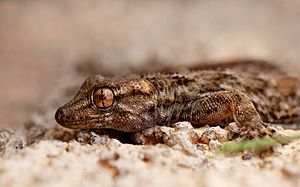East Canary gecko facts for kids
Quick facts for kids East Canary gecko |
|
|---|---|
 |
|
| Conservation status | |
| Scientific classification | |
| Genus: |
Tarentola
|
| Species: |
angustimentalis
|
The East Canary gecko (also called the Canary wall gecko) is a type of lizard found only on the eastern Canary Islands. Its scientific name is Tarentola angustimentalis. These geckos live in many different places, like rocky areas, sandy beaches, gardens, and even inside buildings.
Contents
What Does the East Canary Gecko Look Like?
The East Canary gecko is a strong, plump lizard. It can grow to about 8 centimeters (about 3 inches) long from its nose to the start of its tail, and its tail is usually about the same length. Its head and body are quite flat, and its legs stick out to the sides.
These geckos have special feet with sticky pads all along their toes, which are widest at the tips. This helps them climb walls and ceilings! They also have strong claws on their third and fourth toes. Their skin is mostly smooth, but it has small bumps. Their eyes have vertical pupils, which look like thin lines in bright light, and can be brown or golden.
Their body color can change, but they are usually grayish-brown. They often have a lighter stripe down their back and darker stripes across their body. Their belly is lighter, sometimes with a yellow tint, especially near the tail.
Where Do East Canary Geckos Live?
You can find the East Canary gecko on several of the Canary Islands. These include Fuerteventura, Lanzarote, Lobos, and a few smaller islands just north of Lanzarote.
East Canary Gecko Habitats
These geckos are very common in many different places, from sea level up to about 800 meters (about 2,600 feet) high. They like cliffs, rocky slopes, and even sandy areas with small plants. You might also spot them in farmed fields or inside houses!
What Do East Canary Geckos Eat?
The East Canary gecko mostly eats insects, spiders, and other small creatures without backbones. They are good hunters and catch their food at night.
Reproduction and Life Cycle
Male East Canary geckos are bigger than females. During the time they breed, males will protect their territory and can be quite noisy, making different calls.
Female geckos lay one or more groups of two oval-shaped eggs. Each egg is about 1.2 centimeters (half an inch) long. They hide their eggs in cracks, under stones, or buried in the sand. The eggs usually hatch in about 2 to 3 months.
When baby geckos hatch, they are tiny, only about 2 to 3 centimeters (about 1 inch) long from nose to tail. Their colors are often brighter than the adult geckos. Females can start having their own babies when they are about 6 centimeters (about 2.4 inches) long. These geckos can live for a long time, sometimes up to 17 years when cared for by humans!
An interesting fact about these geckos is that the temperature of the egg determines if the baby will be a male or a female. If the egg is kept at 27°C (about 81°F) or warmer, the baby gecko will be a female. If it's cooler than that, it will be a male.
Conservation Status
The East Canary gecko is listed as "least concern" by the IUCN Red List of Threatened Species. This means that even though they only live in a small area, they are very common in those places. Their homes are not in danger, and their numbers seem to be stable, not decreasing.
See also
 In Spanish: Perenquén majorero para niños
In Spanish: Perenquén majorero para niños


